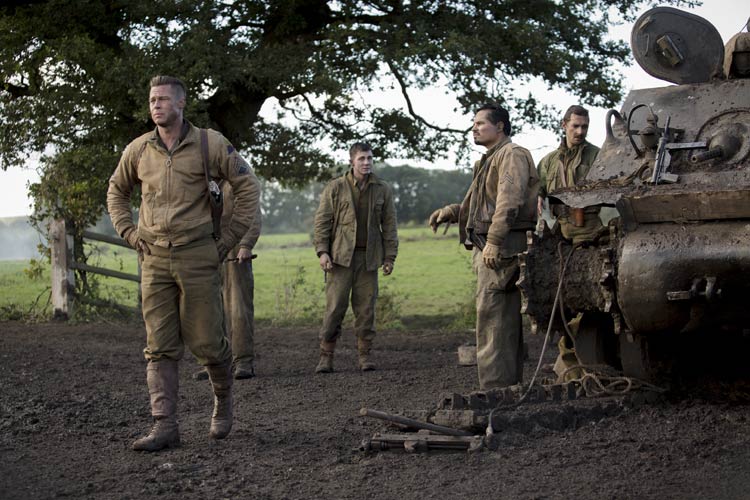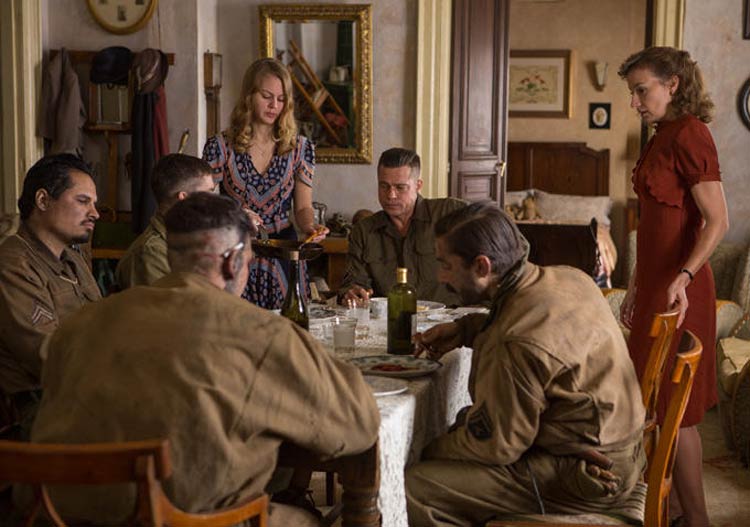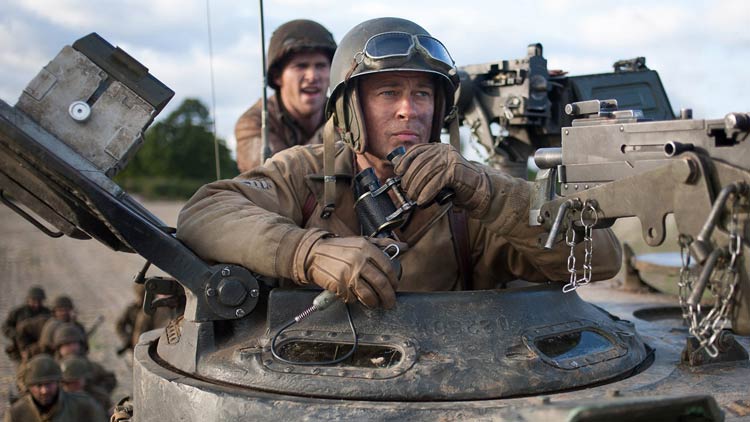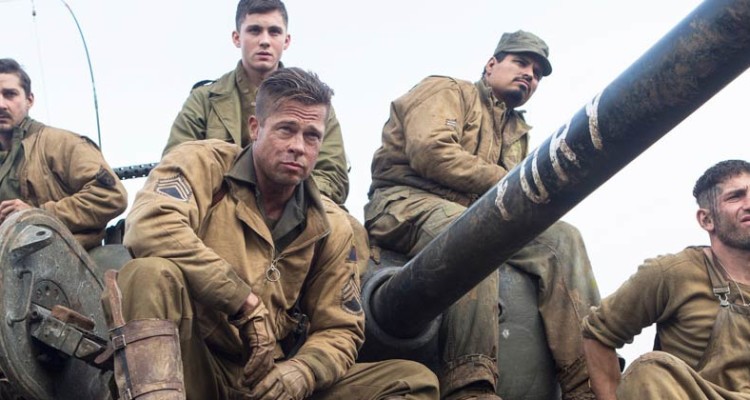by Jorge Carreón.
Yes, David Ayer’s “Fury” is a total boys movie of the most chingón variety. All I kept picturing the entire time were the neighborhood games of Soldier and War I was never invited to as a kid growing up in Pico Rivera. Given Ayer’s affinity for Latino culture, though, I was impressed by how the film hit all the right buttons in terms of that nostalgic sweet spot while offering what the community still expects of this genre. That our most modern screen star Brad Pitt takes center stage only enhances what makes “Fury” a compelling cinematic experience. And it is epic in scope, craft and detail, perhaps Ayer’s most accomplished filmmaking effort to date. Yet, how is it that you may walk away feeling that “Fury” lacked a sense of catharsis?
Ayer’s narrative should be tailor made to offer a sweeping arc that builds with a release emotion at the end of its violent final act. It’s April 1945 and the Allied Forces are staging their final campaign in Europe. US Army Sergeant Don “Wardaddy” Collier (Pitt) is the commander of a Sherman tank, leading a team of battle-weary men, all on a deadly mission behind Nazi lines. Despite the heroism involved, they must first reconcile their own differences about the horrors of being men at war. Facing insurmountable odds, the soldiers face their collective destinies in a fusillade of artillery that goes deep into the night, pushing them to the brink of their sanity…and mortality.

Statements against the horrors of war are nothing new in film, but they can be given a riveting context depending on where we are in our collective history. The ghosts of Vietnam gave birth to such classics as “The Deer Hunter, “Coming Home” and “Platoon.” The Gulf Wars resulted in “Saving Private Ryan” and the exquisite Terence Malick drama “The Thin Red Line.” While Quentin Tarantino turned WWII into an exploitative spectacle with “Inglorious Basterds,” it, too, had its point to make. That’s not to say “Fury” fails in taking a moral stance in the evil that men can do. What proves its undoing is its overtly familiar use of military tropes and archetypes in its attempt to make a statement.
No one can look at the harrowing violence in “Fury” and not think being in battle is glamorous. Where Ayer excels is projecting the sensory overload of war, placing you square in the middle of the horrific and often dehumanizing conditions of combat life. It must be a mind-numbing existence, where you are forced to reconcile your own thoughts on life, death and being the cause of death. Several scenes play to this theme and you will feel the psychological battle involved, particularly with aspects Logan Lerman’s sensitive performance as a fresh recruit to Wardaddy’s group.

However, once “Fury” takes its journey deeper into war-ravaged Germany, the clichés start to stack up and the violence becomes numbing to behold. More, Ayer’s efforts in allowing for pockets of humanity to counter the darker reveals of the soldiers growing madness feel curiously safe and expected. (One scene involving Pitt, Lerman and two German women is the centerpiece of this thread, only to end in a whimper.) By the time the last battle dominates the screen, the exhaustion of the soldiers is palpable. Somehow, it is curiously mirrors by the momentum of the film, too, reaching its end with a soft whisper of relief. We aren’t given the release expected as the entire movie builds to this one moment. I couldn’t tell if it was a personal statement by Ayer on how life and death can happen in an instant or what?
It has to be said that Ayer has an eye for period detail, but that same focus should have been given to most of the men in “Fury” and their dialogue. The charismatic Michael Peña is relegated to a few moments of comic relief, some of which at least are in Spanish, at least reinforcing Latinos are patriots, too. Jon Bernthal never goes beyond being that “crazy redneck,” with a character turnaround that stretches credibility. Shia LaBeouf has given better performances in his tabloid ready exploits, mumbling his lines as if he’s the second coming of Marlon Brando. (Seriously, Shia? Do you need to force subtitles upon us, too?)

As for Lerman, who delivered one of the most heartbreaking star turns in “The Perks of Being a Wallflower?” He’s saddled with a role that all but screams being “the conscience of the audience.” More, he seems to only ape the same nervous humanity that made “Perks” such a wonder to watch, which only diminishes his efforts here.
By now, you’re probably wondering, “Alright, fool. Who didn’t suck in ‘Fury?’”
Two words: Brad Pitt.
Without question, Pitt personifies what it means to be a movie star. In “Fury” he is John Wayne and Steve McQueen, all rolled into one. This later half of Pitt’s career has been interesting to watch. The maturity that comes with getting older has given him great depth as an actor, allowing for an authentic gravity to take hold. You believe him to be this leader and soldier in “Fury,” something that doesn’t quite percolate with the supporting players. Also, because he is able to telegraph Wardaddy’s conflict within, “Fury” is able to find its much-needed moments of soul.
“Fury” is already on track to be the weekend’s box office leader, which means any further notes to the negative won’t matter. Ayer knows how to create mainstream fare that provokes our most basic sensibilities, often to great effect. (“Training Day!”) I will admit to being encouraged by his taking on this period drama and his intentions are clearly in the right place. If only “Fury” showed more consistency and control. But as the final, haunting image of the film will attest, Ayer is starting to move in an exciting new direction. Wherever it leads, I will still be sure to follow.
“Fury” opens nationwide on Friday, October 17.





